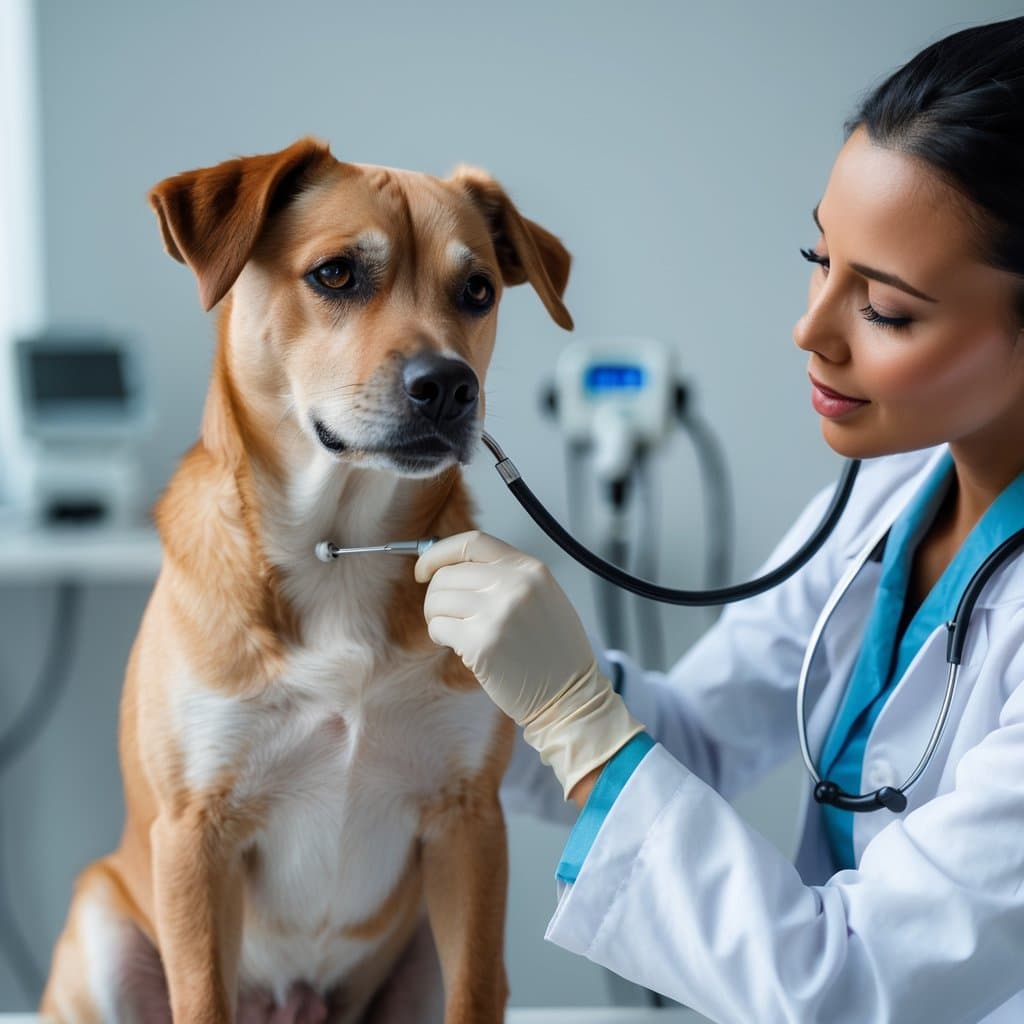
Dogs can get sick with several types of respiratory illnesses that range from mild to severe. These illnesses can spread quickly, especially in crowded places like boarding kennels or dog parks. Recognizing the signs, such as coughing, sneezing, nose or eye discharge, and loss of energy, helps owners act early and protect their pets’ health canine respiratory disease information.
Canine respiratory illnesses, such as kennel cough, are caused by different bacteria and viruses. Most dogs recover with rest and basic care, but some cases need a vet’s help, especially if the symptoms don’t improve. Knowing what to watch for and when to seek help is important for every dog owner.
Key Takeaways
- Canine respiratory illness spreads easily and shows clear symptoms.
- Early recognition and vet care help in recovery.
- Prevention and careful monitoring are important for dog health.
Understanding Canine Respiratory Illness
Respiratory illnesses in dogs can have different causes and often spread quickly in places where dogs interact. Symptoms like coughing, sneezing, or trouble breathing are important warning signs and should not be ignored.
Common Causes of Respiratory Illness
Dogs can get sick from many different viruses and bacteria. Canine influenza and Bordetella bronchiseptica are two well-known germs that cause respiratory diseases in dogs. Bordetella is a key agent behind kennel cough, which is very contagious and often seen in dog shelters and kennels.
Canine infectious respiratory disease complex (CIRDC) sometimes involves several bacteria and viruses at the same time. Outbreaks can happen where dogs stay close together, such as boarding facilities, grooming centers, and dog parks. About nine different bacteria and viruses are known to cause these types of infections, which makes prevention a challenge. For more details, see information on canine infectious respiratory disease complex.
Vaccines can lower the risk for common culprits, but no vaccine covers every cause. Dogs with weaker immune systems are often at higher risk.
Recognizing Symptoms
Dogs with a respiratory illness often show a cough that may sound dry or honking. Some dogs may sneeze or have a runny nose or eyes. It is common for sick dogs to act tired and lose interest in eating.
The most reported signs include:
- Coughing
- Sneezing
- Labored or noisy breathing
- Nasal or eye discharge
- Lethargy (low energy)
- Decreased appetite
Some symptoms, like coughing, can last from a few days to several weeks. Any trouble breathing, bluish gums, or severe tiredness means the dog needs a vet right away. Watch for these clues at home, especially after visits to places where dogs gather, such as dog parks.
How Respiratory Illness Spreads Among Dogs
Respiratory diseases in dogs pass easily from one to another, mainly through the air when a sick dog coughs or sneezes. Germs can also spread by touching shared objects, food bowls, or toys.
Dogs in crowded spots—like kennels, daycare centers, and busy dog parks—are at higher risk for getting sick due to close contact. Some diseases can start spreading even before a dog shows any symptoms.
Cleaning shared areas and vaccinating against major diseases like Bordetella and canine influenza can help lower the risk of an outbreak. Good hygiene and fast isolation of sick dogs are important steps to stop the spread, as explained in this article on canine respiratory disease outbreaks.
Key Symptoms and Diagnosis
Canine respiratory illnesses often cause chronic coughing, frequent sneezing, nasal discharge, and reduced energy. Accurate diagnosis from a veterinarian is important when these signs appear and persist for more than a few days.
Persistent Cough and Sneezing
A persistent cough is one of the main signs of respiratory disease in dogs. This cough may sound dry or wet and can sometimes trigger gagging or retching. Dogs may also exhibit frequent sneezing, which can help move mucus and irritants from their airways.
Owners should pay attention if their dog’s cough lasts more than a few days or gets worse over time. Other concerning signs include coughing that disturbs sleep or stops normal activity. Sneezing may be accompanied by nasal sounds or reverse sneezing. These symptoms may begin mildly and then worsen, especially if left untreated. Learn more about the typical cough and sneezing patterns in canine respiratory illness at the Canine Health Information resource from Cornell University.
Nasal Discharge and Lethargy
Nasal discharge is another major symptom. The fluid may be clear at first but can become cloudy, yellow, or green as the illness progresses. Some dogs develop watery or crusty eye discharge as well. These discharges often signal a viral or bacterial infection affecting the airways.
Lethargy is common and can be severe. Affected dogs may sleep more, lose interest in walks, avoid play, and refuse food. In young puppies or older dogs, this fatigue can be particularly dangerous. Decreased appetite often goes along with tiredness and should not be ignored. More details about nasal discharge and lethargy can be found in the Colorado Department of Agriculture’s canine respiratory disease guide.
Veterinary Diagnostic Procedures
When a dog shows signs of respiratory illness, a veterinarian will start with a physical exam to check for fever, abnormal lung sounds, and difficulty breathing. The vet may ask for a history of the dog’s symptoms and any recent contact with other dogs.
Diagnostic tools can include chest x-rays, blood tests, and swabs from the nose or throat to look for infections. These tests help rule out serious illnesses like pneumonia and identify the most likely causes. Some clinics may also use PCR testing to detect specific viruses or bacteria. For information on how veterinarians diagnose these illnesses, see the advice from the University of Florida’s College of Veterinary Medicine.
Prevention and Risk Reduction
Preventing canine respiratory illness means taking careful steps to protect dogs from diseases like canine influenza and bordetella, especially in places where dogs mix. Actions such as timely vaccination and making healthy choices at dog parks can lower the chance of getting sick.
Vaccination and Immunization
Vaccines help protect dogs from common respiratory diseases, including canine influenza and bordetella (kennel cough). Most veterinarians recommend routine vaccines for these illnesses, especially for dogs that board, attend training, or frequently meet other dogs. Vaccination reduces the risk and severity of infection, but does not make dogs completely immune.
Owners should talk with their vet about which vaccines are right for their dog’s lifestyle and age. Boosters may be needed every year or every few years, depending on the risk of exposure. During outbreaks, it is wise to update vaccines as soon as possible.
Some boarding facilities, groomers, and daycares require dogs to be up-to-date on their shots before visiting. Keeping a record of vaccination status helps protect each dog and the wider dog community. For more details about vaccines and respiratory illness, see this guide on canine respiratory disease prevention.
Safe Practices at Dog Parks
Dog parks are social spaces, but they can also make it easy for sickness to spread. Dogs can catch respiratory illnesses through close contact, shared water, and even the air. If a dog is coughing, sneezing, or acting sick, it is best to keep it home.
Visitors should avoid parks during local outbreaks or if notices report increased cases in the area. Check with park staff or signs for current health updates. Avoid dog parks with poor cleanliness or that look overcrowded.
Bringing water from home in a clean bowl and discouraging dogs from sharing toys or bowls at the park is safer. After leaving, owners can wipe their dog’s paws and fur to remove germs. More tips on keeping dogs safe in public spaces are available at canine respiratory disease outbreak advice.
Treatment and Home Care

Treatment for canine respiratory illness includes both veterinary care and home management. Quick action and proper support can help most dogs recover safely.
Veterinary Treatments and Medications
A veterinarian will first diagnose the type of respiratory illness, which could include kennel cough, pneumonia, or other infections. Treatment depends on the cause. Bacterial infections might need antibiotics, while viral infections are managed with supportive care.
Severe cases, such as pneumonia, may require hospitalization, oxygen therapy, or intravenous fluids. Dogs in distress might need anti-inflammatory medication or cough suppressants. It’s important to follow dosing instructions and finish all prescribed medications.
Vaccines can prevent some respiratory illnesses, like those caused by Bordetella and canine influenza. Dogs showing severe symptoms such as difficulty breathing or blue gums should get emergency care. For more details, visit this page about canine respiratory disease treatment.
At-Home Supportive Care
Home care can help dogs feel more comfortable and support their recovery. Rest is essential—dogs should have a quiet, warm space away from other pets.
Hydration is crucial. Encourage your dog to drink fresh water. Steamy air from a hot shower can loosen mucus and make breathing easier; this is sometimes called steam therapy.
Keep your home clean to reduce dust and smoke. Limit walks and play until symptoms improve. If your dog is coughing or has trouble breathing, monitor them closely.
Isolation helps stop the spread of illness. Sick dogs should stay home until fully recovered. For more tips on home treatments, see these at-home support ideas for dog respiratory illness.
Frequently Asked Questions
Dogs can get respiratory infections that may cause coughing, sneezing, or other symptoms. Understanding treatments, prevention, and warning signs helps keep pets healthy.
What treatments are available for dogs with respiratory illnesses?
Treatment depends on the cause. Dogs with mild symptoms often need rest, fluids, and isolation to prevent spreading illness.
Some cases require prescription medications like antibiotics for bacterial infections, but many viral illnesses do not respond to these drugs. In serious cases, hospitalization may be needed for oxygen therapy or intravenous fluids. Some respiratory diseases are reportedly nonresponsive to commonly prescribed antibiotics, making diagnosis important before treatment begins. More details can be found from the Ohio Department of Agriculture.
How do canine respiratory diseases progress over time?
Most dogs start with mild symptoms like a cough, nasal discharge, or sneezing. For some, these symptoms improve within one to three weeks.
If the illness gets worse, dogs may develop more severe coughing, labored breathing, or loss of appetite. Chronic cases can last a month or more, especially if not treated early or if the dog has other health problems.
Are there vaccines available to prevent respiratory illnesses in dogs?
Yes, vaccines are available for several common canine respiratory diseases. Vaccines for kennel cough (bordetella), canine influenza, and parainfluenza help reduce the risk of infection.
Keeping a dog’s vaccines up to date is an effective way to prevent many of these illnesses. Vaccination reduces not just the risk of getting sick but also the severity if a dog does get infected. The American Veterinary Medical Association has more information on vaccinations.
What signs indicate a dog might have a respiratory infection?
Signs include coughing, sneezing, nasal discharge, watery eyes, and lethargy. Some dogs may run a fever or have trouble breathing.
Owners might notice their pets are less active or lose interest in food. Severe symptoms like persistent coughing, wheezing, or blue gums need quick attention from a vet.
How can kennel cough be distinguished from other respiratory infections in dogs?
Kennel cough usually causes a dry, hacking cough that often sounds like something is stuck in the dog’s throat. The cough can be frequent and harsh.
Other respiratory infections may include wetter coughs, nasal discharge, or more severe breathing problems. Kennel cough is most often spread in places where many dogs gather, like kennels or dog parks.
What is the most prevalent respiratory disease affecting dogs?
Kennel cough, also called canine infectious respiratory disease complex (CIRDC), is the most common contagious respiratory illness in dogs. It is caused by many different bacteria and viruses.
This disease spreads quickly where dogs are close together. Most cases are mild, but complications can occur, especially in puppies or dogs with weak immune systems. Learn more about common symptoms and causes from the Oregon Humane Society.





